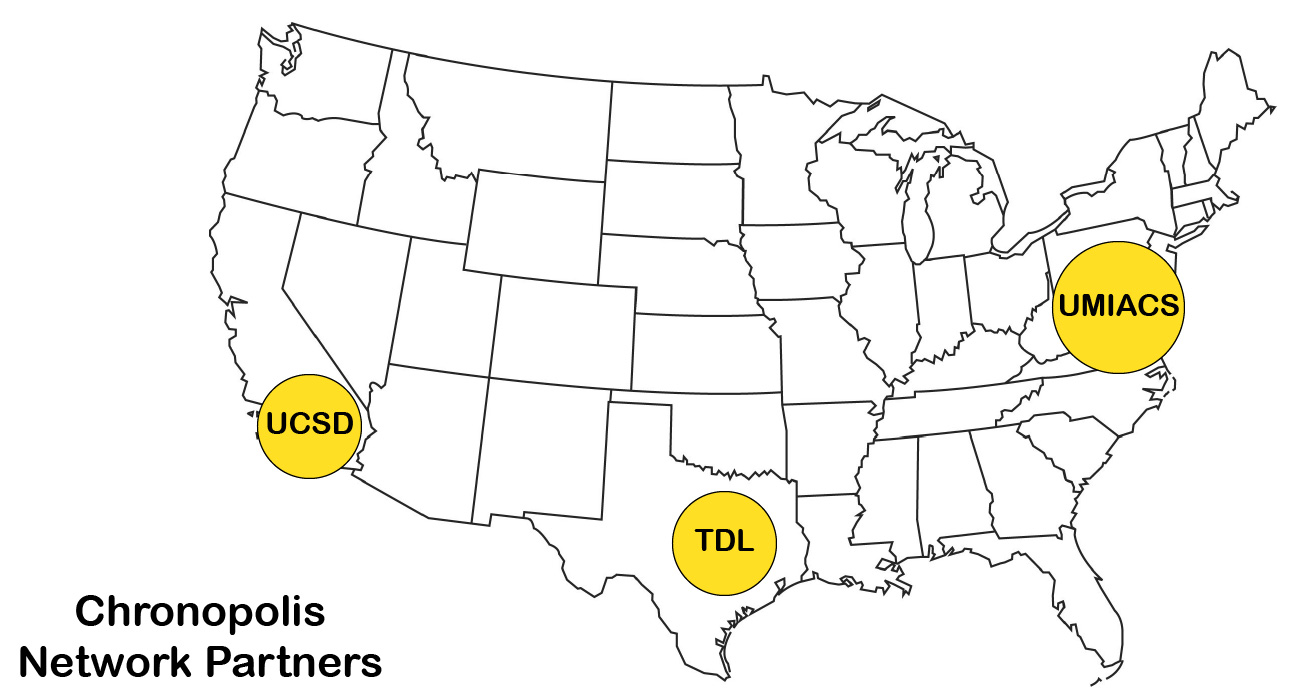About
Chronopolis is a geographically distributed preservation network. All data in the network are replicated among three geographically dispersed partner sites. This geographic distribution ensures that no single catastrophic event will affect the content.

Originally funded by the Library of Congress, the Chronopolis digital preservation network has the capacity to preserve hundreds of terabytes of digital data—data of any type or size, with minimal requirements on the data provider. Chronopolis comprises several partner organizations that provide a wide range of services. The partners include:
- UC San Diego Library (UCSD)
- University of Maryland Institute for Advanced Computer Studies (UMIACS)
- The Texas Digital Library (TDL)
The project leverages high-speed networks, mass-scale storage capabilities, and the expertise of the partners in order to provide a geographically distributed, heterogeneous, and highly redundant archive system.
Features of the project include:
- Three geographically distributed copies of the data
- Curatorial audit reporting
- Development of best practices for data packaging and sharing
Mission Statement
Chronopolis is a digital preservation program for the preservation of long-lived digital data collections. It accomplishes this through the development and implementation of a preservation data grid and its supporting human, policy, and technological infrastructure. Chronopolis is intended as a model for valued digital collections with long-term impact from a variety of academic disciplines. The infrastructure is designed to be content-agnostic, to enable the ingest of collections of all types.
Chronopolis starts with the realization that partnership and collaboration among a specified group of like organizations is necessary to ensure continuity for the lifetime of a collection. Thus it has been designed with multiple organizations providing the preservation infrastructure, tool and software development, and management. This is key not only to providing a robust preservation environment, but also creating a sustainable organizational model, not dependent on any one group.
Services
Chronopolis's preservation infrastructure, tool and software development, and management are provided by multiple organizations, creating both a robust preservation environment and a sustainable organizational model not dependant on any one group.
The Chronopolis Preservation Plan offers the following services:
- Provide long-term preservation of a wide variety of digital content;
- Operate a robust, grid-based storage environment for digital preservation;
- Maintain appropriate preservation metadata relevant to all aspects of the object lifecycle;
- Develop tools and services for digital preservation;
- Devote resources to investigating and planning for new technologies and services;
- Utilize and create community-based standards and systems.
Format obsolescence is not an immediate concern of the Chronopolis system. Instead, this is regarded as the responsibility of the data providers. The single, overriding commitment of the Chronopolis system is to preserve objects in such a way that they can be transmitted back to the original data providers in the exact form in which they were submitted.
TRAC Certification
The Center for Research Libraries (CRL) has certified Chronopolis as a “trustworthy digital repository,” meaning that it meets accepted best practices in the management of digital repositories. The primary metrics used by CRL in its assessment are derived from the Trustworthy Repositories Audit Certification (TRAC).
The TRAC criteria include organizational infrastructure, digital object management, technologies, technical infrastructure, and security. These criteria represent the best current practices and thinking about the organizational and technological needs of trustworthy digital repositories.
The certification process involved three broad steps:
- The Chronopolis team completed a "self-audit," answering all of the questions posed in the TRAC document. This self-audit was sent to CRL, who used it as the basis for their work. The Chronopolis self-audit is available here.
- Next, CRL analyzed the Chronopolis network and the self-audit, including a site visit to talk to Chronopolis staff, and a number of interviews with Chronopolis users and stakeholders. Based on input from this work, the audit team and Chronopolis began an interactive phase, discussing changes and recommendations.
- CRL released the final audit report. This report is available on the CRL site here.